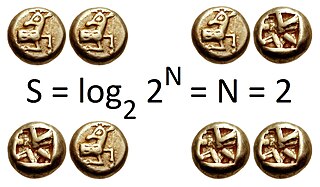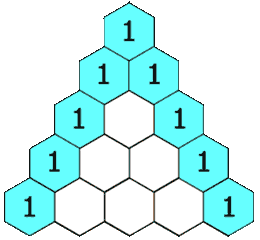
In probability theory and statistics, the binomial distribution with parameters n and p is the discrete probability distribution of the number of successes in a sequence of n independent experiments, each asking a yes–no question, and each with its own boolean-valued outcome: success/yes/true/one or failure/no/false/zero. A single success/failure experiment is also called a Bernoulli trial or Bernoulli experiment and a sequence of outcomes is called a Bernoulli process; for a single trial, i.e., n = 1, the binomial distribution is a Bernoulli distribution. The binomial distribution is the basis for the popular binomial test of statistical significance.

In mathematics, the binomial coefficients are the positive integers that occur as coefficients in the binomial theorem. Commonly, a binomial coefficient is indexed by a pair of integers n ≥ k ≥ 0 and is written It is the coefficient of the xk term in the polynomial expansion of the binomial power (1 + x)n, and it is given by the formula
In elementary algebra, the binomial theorem describes the algebraic expansion of powers of a binomial. According to the theorem, it is possible to expand the polynomial (x + y)n into a sum involving terms of the form axbyc, where the exponents b and c are nonnegative integers with b + c = n, and the coefficient a of each term is a specific positive integer depending on n and b. For example,

The information entropy, often just entropy, is a basic quantity in information theory associated to any random variable, which can be interpreted as the average level of "information", "surprise", or "uncertainty" inherent in the variable's possible outcomes. The concept of information entropy was introduced by Claude Shannon in his 1948 paper "A Mathematical Theory of Communication".
A splay tree is a self-balancing binary search tree with the additional property that recently accessed elements are quick to access again. It performs basic operations such as insertion, look-up and removal in O(log n) amortized time. For many sequences of non-random operations, splay trees perform better than other search trees, even when the specific pattern of the sequence is unknown. The splay tree was invented by Daniel Sleator and Robert Tarjan in 1985.

In mathematics, Pascal's triangle is a triangular array of the binomial coefficients. In much of the Western world, it is named after the French mathematician Blaise Pascal, although other mathematicians studied it centuries before him in India, Persia (Iran), China, Germany, and Italy.
In computer science, a binomial heap is a data structure that acts as a priority queue but also allows pairs of heaps to be merged together. It is important as an implementation of the mergeable heap abstract data type, which is a priority queue supporting merge operation. It is implemented as a heap similar to a binary heap but using a special tree structure that is different from the complete binary trees used by binary heaps. Binomial heaps were invented in 1978 by Jean Vuillemin.
In computer science, a Fibonacci heap is a data structure for priority queue operations, consisting of a collection of heap-ordered trees. It has a better amortized running time than many other priority queue data structures including the binary heap and binomial heap. Michael L. Fredman and Robert E. Tarjan developed Fibonacci heaps in 1984 and published them in a scientific journal in 1987. Fibonacci heaps are named after the Fibonacci numbers, which are used in their running time analysis.
Kademlia is a distributed hash table for decentralized peer-to-peer computer networks designed by Petar Maymounkov and David Mazières in 2002. It specifies the structure of the network and the exchange of information through node lookups. Kademlia nodes communicate among themselves using UDP. A virtual or overlay network is formed by the participant nodes. Each node is identified by a number or node ID. The node ID serves not only as identification, but the Kademlia algorithm uses the node ID to locate values. In fact, the node ID provides a direct map to file hashes and that node stores information on where to obtain the file or resource.
In information theory, the information content, self-information, surprisal, or Shannon information is a basic quantity derived from the probability of a particular event occurring from a random variable. It can be thought of as an alternative way of expressing probability, much like odds or log-odds, but which has particular mathematical advantages in the setting of information theory.
In cryptography, a message authentication code based on universal hashing, or UMAC, is a type of message authentication code (MAC) calculated choosing a hash function from a class of hash functions according to some secret (random) process and applying it to the message. The resulting digest or fingerprint is then encrypted to hide the identity of the hash function used. As with any MAC, it may be used to simultaneously verify both the data integrity and the authenticity of a message.

In graph theory, an m-ary tree is a rooted tree in which each node has no more than m children. A binary tree is the special case where m = 2, and a ternary tree is another case with m = 3 that limits its children to three.
In computer science, the prefix sum, cumulative sum, inclusive scan, or simply scan of a sequence of numbers x0, x1, x2, ... is a second sequence of numbers y0, y1, y2, ..., the sums of prefixes of the input sequence:
In distributed computing, leader election is the process of designating a single process as the organizer of some task distributed among several computers (nodes). Before the task is begun, all network nodes are either unaware which node will serve as the "leader" of the task, or unable to communicate with the current coordinator. After a leader election algorithm has been run, however, each node throughout the network recognizes a particular, unique node as the task leader.
In computer science, Cannon's algorithm is a distributed algorithm for matrix multiplication for two-dimensional meshes first described in 1969 by Lynn Elliot Cannon.
Samplesort is a sorting algorithm that is a divide and conquer algorithm often used in parallel processing systems. Conventional divide and conquer sorting algorithms partitions the array into sub-intervals or buckets. The buckets are then sorted individually and then concatenated together. However, if the array is non-uniformly distributed, the performance of these sorting algorithms can be significantly throttled. Samplesort addresses this issue by selecting a sample of size s from the n-element sequence, and determining the range of the buckets by sorting the sample and choosing p−1 < s elements from the result. These elements then divide the sample into p equal-sized buckets. Samplesort is described in the 1970 paper, "Samplesort: A Sampling Approach to Minimal Storage Tree Sorting", by W. D. Frazer and A. C. McKellar.

Hypercube networks are a type of network topology used to connect multiple processors with memory modules and accurately route data. Hypercube networks consist of 2m nodes. These nodes form the vertices of squares to create an internetwork connection. A hypercube is basically a multidimensional mesh network with two nodes in each dimension. Due to similarity, such topologies are usually grouped into a k-ary d-dimensional mesh topology family where d represents the number of dimensions and k represents the number of nodes in each dimension.
Reduce is a collective communication primitive used in the context of a parallel programming model to combine multiple vectors into one, using an associative binary operator . Every vector is present at a distinct processor in the beginning. The goal of the primitive is to apply the operator in the order given by the processor-indices to the vectors until only one is left. The reduction of sets of elements is an integral part of programming models such as Map Reduce, where a function is applied (mapped) to all elements before they are reduced. Other parallel algorithms use reduce as a primary operation to solve more complex problems. The Message Passing Interface implements it in the operations MPI_Reduce and MPI_Allreduce, with the difference that the result is available at one (root) processing unit or all of them. Closely related to reduce is the broadcast operation, which distributes data to all processors. Many reduce algorithms can be used for broadcasting by reverting them and omitting the operator.
The two-tree broadcast is an algorithm that implements a broadcast communication pattern on a distributed system using message passing. A broadcast is a commonly used collective operation that sends data from one processor to all other processors. The two-tree broadcast communicates concurrently over two binary trees that span all processors. This achieves full usage of the bandwidth in the full-duplex communication model while having a startup latency logarithmic in the number of partaking processors. The algorithm can also be adapted to perform a reduction or prefix sum.
Broadcast is a collective communication primitive in parallel programming to distribute programming instructions or data to nodes in a cluster it is the reverse operation of reduce. The broadcast operation is widely used in parallel algorithms, such as matrix-vector multiplication, Gaussian elimination and shortest paths.

























































